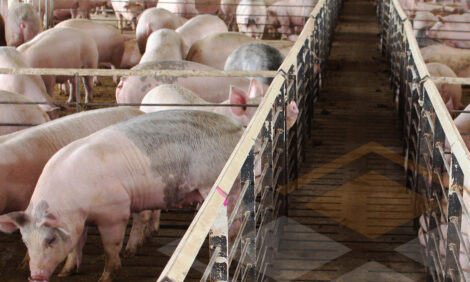



Boar Taint and its Control
Boar taint explained, along with some suggestions on its control are offered in Target Meat Quality No. 6 from BPEX.What is Boar Taint?
Boar taint is an odour or flavour, offensive to some people, which can be evident during the cooking or eating of pork or pork products resulting from high concentrations of skatole and/or androstenone.
Why is Boar Taint a Problem?
Some consumers can detect androstenone in pigmeat at high concentrations (above 1ppm) as a sweat or urine-like odour.
Most consumers can detect skatole at high concentrations (above 0.25ppm) as a faecal or mothball-like odour. Skatole has the larger impact on consumer acceptability compared to androstenone.
Consumers in different countries often react differently to boar taint, as do male and female consumers. The British are generally less critical of pork containing high levels of boar taint than other consumers across Europe, while consumers in Asia, Africa and Latin America are particularly sensitive to androstenone. Similarly, reactions can differ between male and female consumers, with the proportion of females who are very sensitive to boar taint being larger than men, at least regarding androstenone.
Control of Boar Taint
There is a range of ways, both short- and long-term, of minimising the risk of boar taint in pork and pork products. For example, the level of skatole in the fat can be reduced by adjusting management factors such as diet, feeding and rearing conditions and, when altered during the last few weeks before slaughter, diet can have a significant effect on skatole.
|
Skatole |
Pen hygiene
Skatole can be absorbed through skin contact or re-ingestion of faeces; clean lying areas help prevent this.
 |
 |
 |
Ventilation
Inadequate ventilation will result in pigs choosing to lie in the moister areas of the pen – the dunging area – resulting in absorption of skatole through the skin. Check that the ventilation is adequate and keep fans clean and serviced; see Action for Productivity 21 for further advice on ventilation.
Pellet feeding
Studies indicate increased skatole levels in pigs fed the same diet in pellets as compared with meal form.
Low fibre diets
Skatole levels can be reduced by increasing dietary fibre content, particularly types of fibre which the pig can readily ferment, e.g. dried sugar beet pulp. Consult a nutritionist to discuss cost-effective inclusion levels.
Increasing the ratio of barley to wheat may also reduce skatole levels, as barley contains a higher level of fibre.
Protein
Feeding excessive protein can increase the risk of high skatole levels. This can be avoided by practising phase feeding, which varies the level of protein through the animal’s growth.
Low-protein diets are being investigated in a Defra LINK project in which BPEX is involved, a summary can be found by clicking here.
Chicory
Research funded by BPEX has shown that feeding nine per cent chicory for two weeks before slaughter can be effective in reducing backfat skatole concentrations although it is not always reducing the perception of boar taint itself. Chicory is rich in inulin, a complex fibre indigestible in the small intestine, which is able to alter the patterns of microbial fermentation in the large intestine; this can consequently reduce the production of skatole.
Age for weight
Androstenone production is positively related to age/weight, with the development of sexual maturity as boars get older/heavier. Optimising health and nutrition is important to ensure rapid growth and to achieve the target weight at a younger age. In terms of finishing weights, a BPEX-funded project showed that there were no significant differences in taint compound concentrations between 90 and 110kg carcass weight groups (males), indicating that pigs can still be finished at these higher weights without developing boar taint.
Refer to the specifications in the Assured Food Standards assurance standards for fresh pork intended for sale as Red Tractor product, as only carcases which conform to those specifications are eligible to carry that quality mark.
Vaccination against sex hormone production
This stimulates the pig’s own immune system to block the function of the testes temporarily, reducing the production and accumulation levels of boar taint-causing compounds. As well as minimising the risk of boar taint, producers are able to capture the performance, health and carcass quality benefits of rearing male pigs as entire boars for most of the finishing period. At present (June 2011) this is not allowed under the AFS scheme.
Marker-assisted selection
Levels of androstenone in fat are mostly affected by genetic factors controlling its production and excretion as well as by the degree of sexual maturity.
Marker-assisted selection could enable the industry to remove males with high skatole or androstenone levels from the breeding pyramid and reduce the risk of boar taint developing on pork and pork products.
Studies have shown that both compounds have moderate to high values for heritability, with a positive genetic correlation between the two traits. However, direct selection based on these traits could lead to unfavourable side-effects in terms of reproductive performance and productivity.
Instead, identifying a specific section of the DNA which affects these traits could lead to more effective selection (marker-assisted selection). With modern techniques for identifying specific genetic markers, progress is being made but it may take another few years before it is ready for practical use in pig production.
Breeding only female piglets
Another method to control boar taint is to select the sex of the piglet before birth using sorting based on sex chromosome and artificial insemination. Although this method has been successfully used in cattle breeding, it is still under research and no economic or practical solution exists in pig production yet.
July 2011





